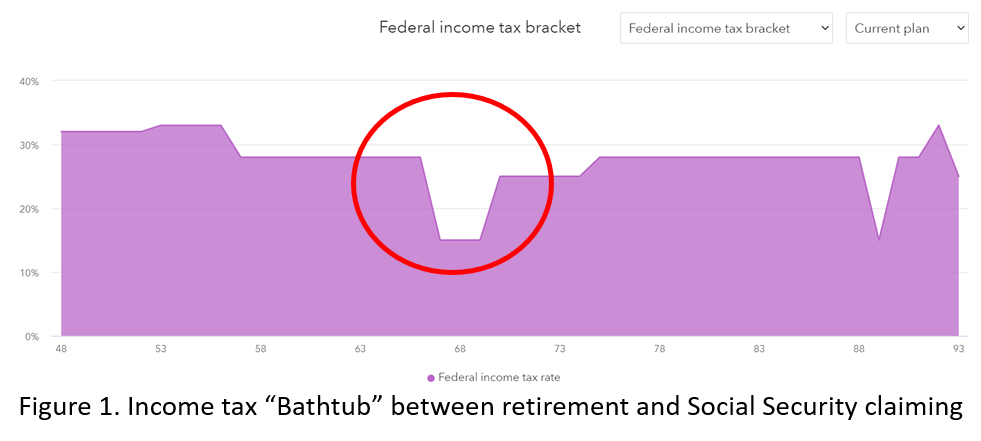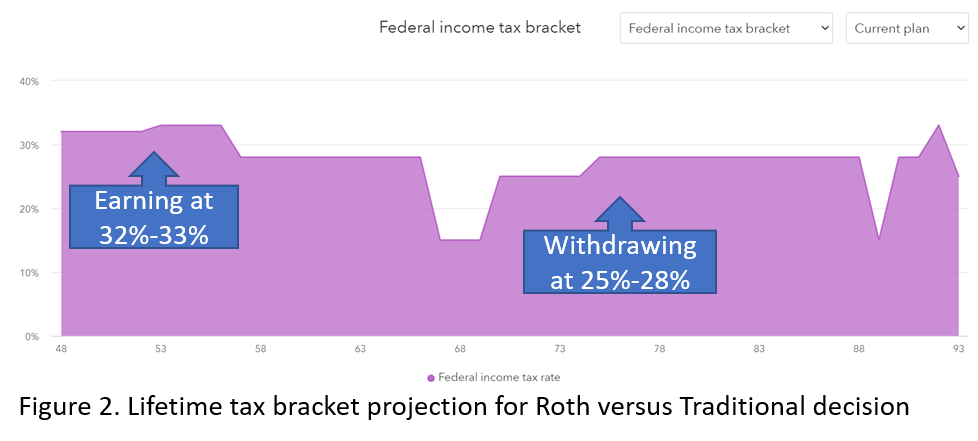RMD-Not Just a 4-Letter Word
It’s the end of the year and our future selves will be thinking about Required Minimum Distributions (RMDs) when the calendar hits December. While most of us aren’t worried about our 75-year-old self’s problems, you might want to read on for a glimpse of the future.
RMD 101
An RMD is the amount that Uncle Sam forces you to take from pre-tax retirement accounts such as Traditional IRAs, 401(k)s, and TSP so that you finally start paying some tax on those dollars after decades of compounding. The beginning age for RMD was 70.5 until 2020, then became 72 until 2023. It’s now 73 until 2032 at which point it changes to 75. Thus, for most readers of this article, think age 75. It’s important to note that those who had to start taking RMDs at 70.5 or 72 must continue. They don’t get a start-stop-start opportunity based on recent changes in the law.
I’ll frame this discussion around a common question…
Question: At age 75 when you are forced to take RMDs from your retirement account(s), but do not need the money, how would you invest the money? My thought is to continue to invest aggressively even though you are forced to take withdrawals. What are your thoughts?
Answer: It depends.
Moving past the tired it depends answer, the overwhelming majority of folks taking money out of their IRA in retirement take more than the RMD amount because they need the dollars to support income needs. So, it’s a relatively small number of wealthy tax-payers that are truly pained by the RMD.
As a refresher, the RMD is calculated based on the prior-year’s ending balance of Traditional IRAs and 401(k)s. It’s an increasing fraction based on life-expectancy. The first RMD is about 4%. At age 115 and greater, it’s about 50%.
Failing to take an RMD carries a 25% penalty tax on the RMD amount (10% if the issue is corrected in a timely manner). This penalty used to be 50% and the IRS would frequently forgive it, however, now that it’s significantly reduced many experts think the IRS may be less charitable.
For those that do expect RMDs to be larger than needed distributions for lifestyle, there are a few good options to start off with:
- Roth conversions. Many tax-payers will have a “bathtub” where their marginal income tax rate dips after calling knock-it-off on a paycheck, but before claiming Social Security. Figure 1. below shows an example of what that might look like. The earlier that you set the throttle at “paycheck optional,” the longer you have to suppress your income tax bracket before claiming social security and getting stuck in the high block on income tax rates.
Social Security, along with other guaranteed income sources like (military) pensions create an income floor, and therefore a tax bracket floor. Roth converting while that floor is at its lowest creates the lowest potential tax bracket.
Dollars converted at a lower tax bracket don’t become RMDs at a higher tax bracket. In fact, because (currently) Roth IRAs don’t have RMDs, they don’t become RMDs at all.

- Qualified Charitable Distributions (QCDs). Starting at age 70.5, it’s possible to send up to $100K from a Traditional IRA directly to a qualified charity. A QCD works like an above-the-line deduction, but it can’t be “double tapped” and also considered a charitable donation for itemizing deductions. A QCD in lieu of an RMD lowers the tax bill in the year of the donation, helps families achieve gifting goals, and reduces the IRA balance overall. A strategy might include doing a QCD for the RMD amount, then Roth converting some additional dollars to shape the tax bill over one’s remaining years as well as lowering the heirs’ tax bill by leaving more Roth dollars behind.
- Invest what you don’t spend. Uncle Sam wants money flowing through the economy, not permanently trapped in investment accounts. This makes the money taxable and provides the lifeblood of our economy: consumer spending.
So, if RMDs exceed what a family chooses to spend or gift, then yes, investing in line with a family’s investment game plan remains the last option.
Exactly what 75-year-olds will choose to invest in is of course, highly individualized. That said, we entered this merge thinking about being forced to recognize income and therefore seeking a tax efficient option for that income.
This might look like seeking non-dividend-paying stocks, tax-exempt municipal bonds, or low-cost index ETFs for those excess RMD dollars. Such investments would be expected to grow, ostensibly for legacy purposes, but not add (much) to the annual interest, dividend, or capital gains tax bill.
Another option might be an annuity. Annuities provide tax-deferred growth (if they provide growth) and are generally thought of as “longevity insurance” since they pay until you die. The problem with an annuity is that the remainder of the investment usually goes to the insurance company after you die. If you’re in your 70s and don’t need RMD dollars to live on, donating them to an insurance company’s coffers would need to be a family goal before I’d recommend it as a use for excess RMD amounts.
A special type of annuity called a QLAC (Qualified Longevity Annuity Contract) gets extra unique treatment. A QLAC can be purchased with up to $200K of IRA dollars (2024) in lieu of taking an RMD. Payments from the QLAC would have to start by age 85, so this strategy could defer some taxation for an extra 10 years. Given life expectancy after age 85, this strategy is a way of saying, “I’d rather make an insurance company wealthy than pay taxes.” To each their own.
Funding Long-Term Care, either through insurance or saving/investing to cover the cost of it could be a great use of excess RMD dollars. Long-term care insurance is going to be pricey if it’s still offered to a 75+-year-old, so arguably, a long-term care plan probably needed to be established prior to RMD age. Shoring up a long-term care plan is definitely worth considering for excess RMD dollars.
Gifting to family will be great fit for many families. Since the average age for receiving an inheritance is 60, gifting excess RMD dollars at 75 implies that children receive money starting in their 40s-50s where it can arguably create a greater life impact. Grandchildren could receive the money even earlier and achieve earlier fulfilling experiences with such a gift.
Given the gymnastics required to effect these “cure” strategies, “prevention” strategies probably sound pretty appealing right about now.
Some strategies to minimize or even prevent RMDs include the following:
Roth, Roth, and more Roth. Contributing to Roth IRAs in any year that you’re below the cutoff ($230K for 2024) means you’re unlikely to ever be forced to take an RMD on those dollars. Contributing to the Roth TSP/401(k) helps too.
A possible snag is that contributing to a Roth IRA, in say the 32% bracket is leaving the tax man a tip if you could withdraw those dollars in the 25% bracket during retirement. Figure 2 shows an example of how that can work out poorly, but the critical factor is correctly estimating one’s tax bracket over the decades.

YOLO. While Uncle Sam wants dollars flowing through the economy to create general prosperity and fund its operations, most of us will get more lifetime fulfillment from spending and giving our dollars than preparing to test the “hearse has no trailer hitch” theory. Keeping a realistic balance between spending and saving can boost happiness and mitigate RMDs.
Taxable Brokerage vs. Non-Deductible IRA. This is a bit of a can of worms, but if you invest $7K in a non-deductible Traditional IRA (the 2024 limit under age 50), having paid 24% income tax and the account earns 10% for 30 years, you’ll have $122,146. If you took the whole amount as an RMD while in the 25% tax bracket, you’d pay $28,786 in income tax on the $115,146 of earnings.
If, however, you invest the $7K in a taxable brokerage in a hypothetical basket of non-dividend-paying stocks then you’d never have any capital gains tax on those dollars through the years. If those investments earned the same 10% over 30 years, you’d still have $122,146. If you took the whole amount out as a liquidation, you’d pay $17,272 in capital gains tax (assuming 15%) on the $115,146 of earnings.
What’s more, the taxable investment would never have an RMD and the entire amount could be left to heirs with a step-up in basis, potentially eliminating any tax on the gain. It would also be possible to donate the appreciated shares to charity, reducing estate size and creating a tax deduction in the donation year.
Cleared to Rejoin
As is often my method, I’ve been asked for the time and responded with instructions for building a clock. Hopefully this helps paint the picture that RMDs are rarely a real problem for most retirees. They can be managed and avoided with either ounces of prevention or pounds of cure. The important thing is to start planning now so you avoid an unpleasant surprise for your 75th birthday!
Fight’s On!
Winged Wealth Management and Financial Planning LLC (WWMFP) is a registered investment advisor offering advisory services in the State of Florida and in other jurisdictions where exempted. Registration does not imply a certain level of skill or training.
This communication is for informational purposes only and is not intended as tax, accounting or legal advice, as an offer or solicitation of an offer to buy or sell, or as an endorsement of any company, security, fund, or other securities or non-securities offering. This communication should not be relied upon as the sole factor in an investment making decision.
Past performance is no indication of future results. Investment in securities involves significant risk and has the potential for partial or complete loss of funds invested. It should not be assumed that any recommendations made will be profitable or equal the performance noted in this publication.
The information herein is provided “AS IS” and without warranties of any kind either express or implied. To the fullest extent permissible pursuant to applicable laws, Winged Wealth Management and Financial Planning (referred to as “WWMFP”) disclaims all warranties, express or implied, including, but not limited to, implied warranties of merchantability, non-infringement, and suitability for a particular purpose.
All opinions and estimates constitute WWMFP’s judgement as of the date of this communication and are subject to change without notice. WWMFP does not warrant that the information will be free from error. The information should not be relied upon for purposes of transacting securities or other investments. Your use of the information is at your sole risk. Under no circumstances shall WWMFP be liable for any direct, indirect, special or consequential damages that result from the use of, or the inability to use, the information provided herein, even if WWMFP or a WWMFP authorized representative has been advised of the possibility of such damages. Information contained herein should not be considered a solicitation to buy, an offer to sell, or a recommendation of any security in any jurisdiction where such offer, solicitation, or recommendation would be unlawful or unauthorized.

